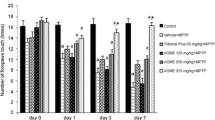The development of means of the prevention and treatment of age-related neurodegenerative diseases, as well as geroprotectors, among other things, is based on the inflammatory and free radical theories of aging. In this context, we studied the effect of sodium monophenol 3-(3’-tert-butyl-4’-hydroxyphenyl)propyl thiosulfonate (TS-13) on the behavioral and locomotor activity of C57BL/6 mice in modeling Parkinson’s disease by MPTP neurotoxin injection. TS-13 administration significantly improved orientation and exploratory activity and emotional response of the animals in the open field test, but did not affect the increase in anxiety caused by MPTP injection. Long-term (6 months) TS-13 administration did not suppress spontaneous motor activity in BALB/c mice and slightly increased their exploratory activity.
Similar content being viewed by others
References
Rogaev EI. Different pathways to neurodegeneration. Biochemistry. 2018;83(9):1007-1008. doi: https://doi.org/10.1134/S0006297918090018
Shields HJ, Traa A, Van Raamsdonk JM. Beneficial and detrimental effects of reactive oxygen species on lifespan: a comprehensive review of comparative and experimental studies. Front. Cell Dev. Biol. 2021;9:628157. doi: https://doi.org/10.3389/fcell.2021.628157
Lee J, Kim HJ. Normal aging induces changes in the brain and neurodegeneration progress: review of the structural, biochemical, metabolic, cellular, and molecular changes. Front. Aging Neurosci. 2022;14:931536. doi: https://doi.org/10.3389/fnagi.2022.931536
Zenkov NK, Kozhin PM, Chechushkov AV, Kandalintseva NV, Martinovich GG, Menshchikova EB. Oxidative stress in aging. Uspekhi Gerontol. 2020;33(1):10-22. Russian. doi: https://doi.org/10.34922/AE.2020.33.1.001
Cobley JN, Fiorello ML, Bailey DM. 13 reasons why the brain is susceptible to oxidative stress. Redox Biol. 2018;15:490-503. doi: https://doi.org/10.1016/j.redox.2018.01.008
Tebay LE, Robertson H, Durant ST, Vitale SR, Penning TM, Dinkova-Kostova AT, Hayes JD. Mechanisms of activation of the transcription factor Nrf2 by redox stressors, nutrient cues, and energy status and the pathways through which it attenuates degenerative disease. Free Radic. Biol. Med. 2015;88(Pt B):108-146. doi: https://doi.org/10.1016/j.freeradbiomed.2015.06.021
Merelli A, Repetto M, Lazarowski A, Auzmendi J. Hypoxia, Oxidative Stress, and Inflammation: Three Faces of Neurodegenerative Diseases. J. Alzheimers Dis. 2021;82(S 1):S109-S126. doi: https://doi.org/10.3233/JAD-201074
Rivas F, Poblete-Aro C, Pando ME, Allel MJ, Fernandez V, Soto A, Nova P, Garcia-Diaz D. Effects of polyphenols in aging and neurodegeneration associated with oxidative stress. Curr. Med. Chem. 2022;29(6):1045-1060. doi: https://doi.org/10.2174/0929867328666211101100632
Rahman MM, Rahaman MS, Islam MR, Rahman F, Mithi FM, Alqahtani T, Almikhlafi MA, Alghamdi SQ, Alruwaili AS, Hossain MS, Ahmed M, Das R, Emran TB, Uddin MS. Role of Phenolic Compounds in Human Disease: Current Knowledge and Future Prospects. Molecules. 2021;27(1):233. doi: https://doi.org/10.3390/molecules27010233
Menshchikova E, Tkachev V, Lemza A, Sharkova T, Kandalintseva N, Vavilin V, Safronova O, Zenkov N. Water-soluble phenol TS-13 combats acute but not chronic inflammation. Inflamm. Res. 2014;63(9):729-740. doi: https://doi.org/10.1007/s00011-014-0746-0
Komleva Y, Chernykh A, Lopatina O, Gorina Y, Lokteva I, Salmina A, Gollasch M. Inflamm-Aging and Brain Insulin Resistance: New Insights and Role of Life-style Strategies on Cognitive and Social Determinants in Aging and Neurodegeneration. Front. Neurosci. 2021;14:618395. doi: https://doi.org/10.3389/fnins.2020.618395
Gaynutdinov PI, Kozhin PM, Chechushkov AV, Martinovich GG, Kholshin SV, Kandalintseva NV, Zenkov NK, Menshchikova EB. Inverse relationship between the antioxidant activity of structurally related synthetic monophenols and their toxicity in tumor cells. Sib. Nauch. Med. Zh. 2018;38(1):22-31. Russian. doi: https://doi.org/10.15372/SSMJ20180104
Bakhtiyarova ShK, Kapysheva UN, Ablaykhanova NT, Baimbetova AK, Zhaksymov BI, Korganbaeva AA, Ydyrys A, Bolatkhan MB, Dautova MB. Behavior of animals in various tests. Mezhdunar. Zh. Priklad. Fundam. Issled. 2017;(8-1):92-96. Russian.
Sudakov SK, Nazarova GA, Alekseeva EV, Bashkatova VG. Estimation of the level of anxiety in rats: differences in results of open-field test, elevated plus-maze test, and Vogel’s conflict test. Bull. Exp. Biol. Med. 2013;155(3):295-297. doi: https://doi.org/10.1007/s10517-013-2136-y
Shoji H, Miyakawa T. Effects of test experience, closed-arm wall color, and illumination level on behavior and plasma corticosterone response in an elevated plus maze in male C57BL/6J mice: a challenge against conventional interpretation of the test. Mol. Brain. 2021;14(1):34. doi: https://doi.org/10.1186/s13041-020-00721-2
Author information
Authors and Affiliations
Corresponding author
Additional information
Translated from Byulleten’ Eksperimental’noi Biologii i Meditsiny, Vol. 175, No. 2, pp. 233-238, February, 2023
Rights and permissions
Springer Nature or its licensor (e.g. a society or other partner) holds exclusive rights to this article under a publishing agreement with the author(s) or other rightsholder(s); author self-archiving of the accepted manuscript version of this article is solely governed by the terms of such publishing agreement and applicable law.
About this article
Cite this article
Menshchikova, E.B., Khrapova, M.V., Kozhin, P.M. et al. Protective Effect of a New Monophenolic Antioxidant TS-13 in a Mouse Model of Parkinson’s Disease. Bull Exp Biol Med 175, 265–269 (2023). https://doi.org/10.1007/s10517-023-05847-6
Received:
Published:
Issue Date:
DOI: https://doi.org/10.1007/s10517-023-05847-6




